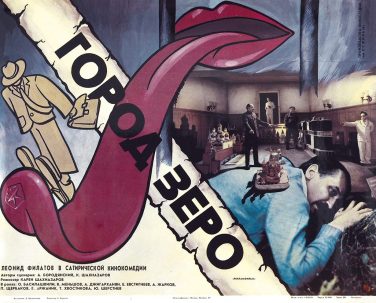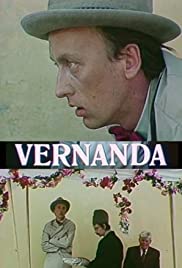Here we’re going back to a very particular time and place: the Soviet Union, circa 1988. A pivotal time in Soviet history, ’88 was essentially the calm before the storm,with a series of major revolutions a year away and the fall of communism following in 1991. Yet for those who lived through that era, a sense of change was already in the air in 1988, as can be seen in two very distinct films from that year.
For an effective barometer of the fears and desires of a nation’s populace one need only look at the films that nation turns out. Think of the dark and unsettled film noirs that packed Hollywood’s release slate in the wake of WWII, and the precedent-shattering experimental cinema that marked the supremely unsettled days of the late 1960s and early 70s.
The changing moods of the Soviet Union were likewise reflected in its films. While American cinema of the late 1980s was marked by jingoistic Reagan-friendly action movies, Russia’s tended to be steeped in “chernukha,” defined as “Pessimistic neo-naturalism and muckraking.” Soviet cinema in the first half of the decade may have contained its share of high-spirited, commercially minded movies like PIRATES OF THE TWENTIETH CENTURY/PIRATY XX VEKA (1980), INCIDENT AT MAP GRID 36’-80’/SLUCHAY V KVADRATE ‘36-80’ (1982) and TORPEDO BOMBERS/TORPEDONOSTSY (1983), but the films of the second grew increasingly gritty and introspective—see COURIER/KURYER (1986), LITTLE VERA/MALENKAYA VERA (1988) and THE HUMBLE CEMETERY/SMIRENNOE KLADBISCHCHE (1989).
 It may seem wrong to place CITY ZERO/ZEROGRAD and VERNANDA, two overtly surreal Soviet made dramas from 1988, in the chernukha category, but I think they fit. That CITY ZERO was made by Karen Shakhnazarov, the director of the aforementioned COURIER (a pioneering entry in the chernukha line-up), underlines its bonafides, as does the fact that it was Russia’s official submission for the Best Foreign Language Academy Award in 1990.
It may seem wrong to place CITY ZERO/ZEROGRAD and VERNANDA, two overtly surreal Soviet made dramas from 1988, in the chernukha category, but I think they fit. That CITY ZERO was made by Karen Shakhnazarov, the director of the aforementioned COURIER (a pioneering entry in the chernukha line-up), underlines its bonafides, as does the fact that it was Russia’s official submission for the Best Foreign Language Academy Award in 1990.
CITY ZERO has a suit-wearing guy (Leonid Filatov) stepping off a train in a mysterious town where he’s looking to do business. That he’s stepped into a madhouse becomes clear quite quickly, when Filatov enters the office of his client to find a stark naked secretary going about her business as if nothing is amiss; he’s also informed that the fellow he was supposed to meet drowned eight months earlier. In a restaurant he’s served a cake styled as an exact replica of his face and head, which the waiter gleefully carves up. When Filatov protests that he didn’t even order dessert, another waiter shoots himself. More weirdness follows, including an elevator ride into the basement of a building that turns out to contain an incredibly elaborate wax museum depicting the entire history of Russia, and a kid who approaches the protagonist and predicts the day and manner of his death. Worst of all is that no matter how hard he tries the poor guy can’t seem to leave the town, as the roads out all lead to dead ends, and he becomes directly entangled in its machinations when the cops open an investigation into the waiter’s suicide.
Shakhnazarov lends the proceedings a spare, deliberate style that in its quiet way manages to compel even when the “action” flags. To western viewers in 1991 (when the film made its belated theatrical bow in the US) the proceedings played like a straightforward exercise in weirdness-for-weirdness’ sake (with Kafka and David Lynch being two comparisons that sprang readily to mind), but to those residing in Russia in the late 1980s it apparently seemed like (in the words of one Soviet resident) a “documentary” of “the Soviet way of life of the period.”
Incidentally, Shakhnazarov followed this bizarre triumph with the Malcolm McDowell headlined surreal thriller ASSASSIN OF THE TSAR/TSAREUBIYTSA (1991), the time travel comedy DREAMS/SNY (1993), and the absurdist historical drama POISONS, OR THE WORLD HISTORY OF POISONING/YADY, ILI VSEMIRNAYA ISTORIYA OTRAVLENIY (2001) before mellowing out with more conventional (but still impressive) likes of AMERICAN DAUGHTER/AMERIKANSKAYA DOCH (1995), DAY OF THE FULL MOON/DEN POLNOLUNIYA and THE RIDER NAMED DEATH/VSADNIK PO IMENI SMERT (2004).
The 29 minute VERNANDA hailed from Soviet occupied Estonia. The film was directed by Roman Baskin and scripted by the acclaimed  novelist Arvo Valton, a.k.a. Estonia’s answer to Franz Kafka. Valton’s writings have inspired a number of beautifully perplexing animated shorts (including NURIL, 1985, LET ME PASS/RAZRESHITE PROYTI, 1987, and ALONE WITH NATURE/NAEDINE S PRIRODY, 1988), with the live action VERNANDA being an adaptation of his short story “Vernanda Bread” (an English translation of which can be found in the Northwestern University Press published ESTONIAN SHORT STORIES). The film takes a number of liberties with the text (the ending in particular), but the story’s atfully surreal core was transposed to the screen virtually intact.
novelist Arvo Valton, a.k.a. Estonia’s answer to Franz Kafka. Valton’s writings have inspired a number of beautifully perplexing animated shorts (including NURIL, 1985, LET ME PASS/RAZRESHITE PROYTI, 1987, and ALONE WITH NATURE/NAEDINE S PRIRODY, 1988), with the live action VERNANDA being an adaptation of his short story “Vernanda Bread” (an English translation of which can be found in the Northwestern University Press published ESTONIAN SHORT STORIES). The film takes a number of liberties with the text (the ending in particular), but the story’s atfully surreal core was transposed to the screen virtually intact.
It begins, once again, with a man stepping off a train. The man, played by Sulev Luik, is embarking on a twenty minute stop in the town of Vernanda, which like City Zero turns out to be a self-contained community filled with weirdos. Luik buys a loaf of bread in a tiny bakery before heading back to the train station, only to be informed that his train has left. Even worse, Luik discovers that the bread loaf he thought he purchased is actually a ticking bomb, and that the bakery where he bought it has been blown up. Bombs are apparently quite common in Vernanda, and Luik’s attempts at exchanging, bartering or simply discarding the thing are constantly rebuffed, as are his attempts at escaping the town.
The political overtones of VERNANDA are less overt than those of the previous film, but just as evident. The fact that the MacGuffin (or object that propels the narrative) is a potential agent of destruction that’s given out quite nonchalantly is not lost on Baskin and Valton, who’ve provided an outwardly humorous account bearing dark, oppressive undertones. Superbly wrought sound design, marked by long periods of unnerving silence broken only by discordant ambient sounds and music cues, and highly evocative yet unpretentious imagery round out a film that is in many respects superior to the vastly acclaimed CITY ZERO.
Certainly the driving conception behind these two films didn’t originate with them. Closed cities, or restricted areas that don’t appear on maps, were quite common in the Soviet Union, and many still exist (see the 2016 documentary CITY 40), while connoisseurs of Soviet and/or Eastern European media will recognize an idea that reached its apotheosis two decades prior to 1988. VERNANDA’s source text “Vernanda Bread” has a 1968 copyright date, and Ferenc Karinthy’s novel METROPOLE, published in Hungary—another Soviet territory—appeared in 1970. About a businessman on his way to a conference in Helsinki who finds himself in a city whose customs, language and currency are completely alien, METROPOLE is an obvious precursor to the oppressive strangeness of CITY ZERO and VERNANDA—which, again, probably won’t seem all that strange to those who lived through the Soviet era.
Furthermore, that strangeness would appear to be creeping into the western world. In an increasingly unsettled and fragmented—or Balkanized—post-Trump landscape, it seems the ideal chronicler of our present era would be Franz Kafka or David lynch, or perhaps Karen Shakhnazarov, Arvo Valton or Roman Baskin. In time CITY ZERO and VERNANDA will doubtless stop feeling like exercises in strangeness (however artful) to us in the US, and come to play like models of gritty realism—and that time, I predict, will not be long in coming.
